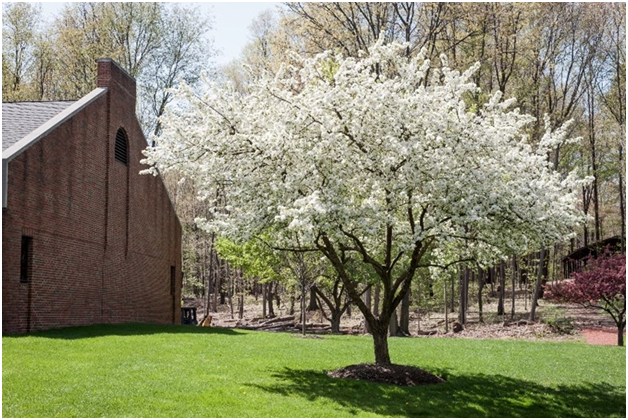Spring is a great time to give trees the extra TLC they need to make it through the rest of the year. These tips from Rick Close, Senior Consulting Arborist for Davey Tree in Pennsylvania, New Jersey, and Delaware, will ensure your trees are prepared for spring and the coming years.
1. Clean up: Prune and tend to trees.
- Clean up unsafe, broken or hanging branches that were damaged by winter weather.
- Any pruning that cannot be managed from the ground should be handled by a certified arborist.
- Some species should be avoided in the spring due to threat of disease or pest infestation from open pruning wounds. A certified arborist knows what trees to prune and when to fix health risks.
- Have a certified arborist inspect any trees that you feel are unsafe or at risk of falling.

2. Prepare
- Identifying and fixing a potentially damaging tree could mean saving thousands of dollars, or even your home.
- Cable, brace or remove weak limbs to prepare for severe weather. Consider lightning protection installation on mature or treasured trees in advance of spring storms.
3. Plant and Care: Mulch your landscape.
- Spring is a great time to plant new trees and shrubs. Consult a certified arborist or your local garden center professional to determine the right tree for your space.
- Mulching is one of the most beneficial practices a homeowner can use for better tree health. It conserves soil moisture, controls weeds, reduces potential damage from mowers and provides the organic matter trees need beneath the soil surface. But do not volcano mulch! Ensure mulch is pulled 2 inches to 3 inches away from the trunk, allowing the base of the tree to be exposed. This lets moisture escape, reducing the growth of fungi and minimizing the risk of decay.
- Apply a slow-release fertilizer before trees and shrubs enter peak growing season. This replaces nutrients needed for growth. The right fertilizer provides necessary nutrients to the landscape and is part of a good soil health program.
4. Look Up: Check and inspect trees and shrubs.
- Most trees are leafing out and flowering in spring. If one area is looking sparse, something might be wrong. Often times when a tree is stressed, branches die from the top down. Tree stress can be caused by insects, diseases, drought, soil compaction or root issues.
- Yellowing leaves could be a sign of excess water from winter or spring storms, indicating poor soil drainage and too much moisture.
- While healthy trees bend along with the wind, decayed wood may crack and break. Look for wounds, holes and cankers or peeling bark. Inspect trees and shrubs for insects and diseases. If not sure, contact a certified arborist.
- Finally, check the roots. Look for stunted growth, discolored, loose, or soft wood and mushroom-like fungi growing near the base of the tree. Certain fungi can weaken wood tissue, resulting in cracks, seams and other internal decay and wounds. This weakened wood can also lead to the tree or parts of it breaking and falling unexpectedly.
About the Author
The Davey Tree Expert Company provides research-driven tree services, grounds maintenance and environmental solutions for residential, utility, commercial and environmental partners across North America. As one of the largest employee-owned companies in the U.S., Davey has been dedicated to creating and delivering sustainable solutions for 140 years. Become part of the Davey legacy and apply today.

















